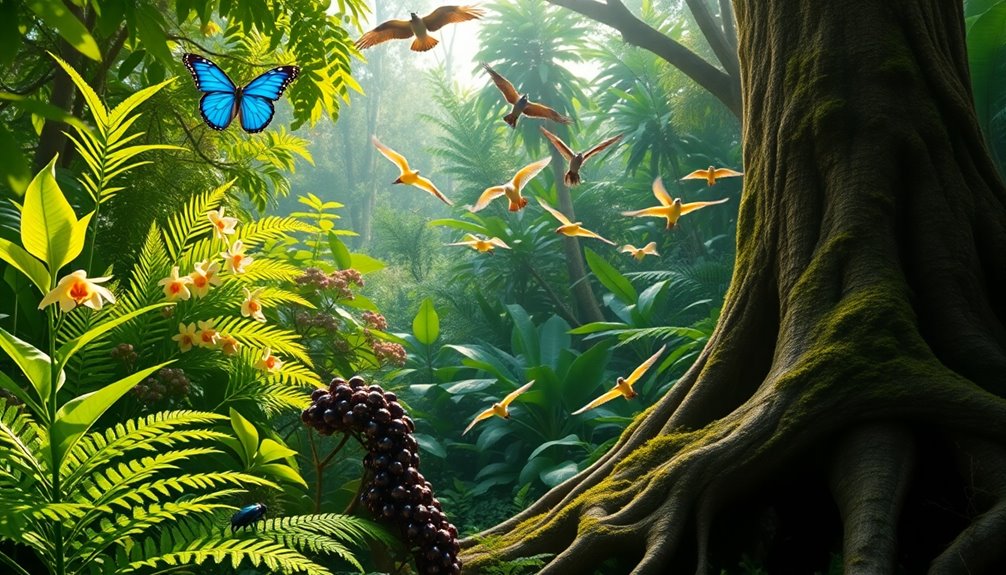Biodiversity means the variety of living organisms on our planet, with over 8.7 million species, including plants, animals, and fungi. It's vital for maintaining healthy ecosystems that directly impact your food security, health, and climate stability. If biodiversity declines, you face economic consequences and a loss of essential services like pollination and clean water. Many species are at risk of extinction due to human activities, highlighting the urgent need for conservation. By understanding biodiversity, you can appreciate its role in your life and recognize why preserving it benefits us all. There's much more to discover about its significance.
Key Takeaways
- Biodiversity encompasses the variety of living organisms, crucial for healthy ecosystems that support human well-being and food security.
- It provides essential ecosystem services, contributing around $125 trillion annually, including pollination, climate regulation, and water purification.
- Biodiversity loss threatens approximately 1 million species, risking significant economic costs and destabilizing ecosystems that support life.
- Conservation efforts, including protected areas and community involvement, are vital for preserving biodiversity and restoring ecological balance.
- Engaging in local conservation projects empowers communities to protect natural resources and promote sustainable practices for future generations.
Definition of Biodiversity

Biodiversity, a term that captures the essence of life on Earth, refers to the incredible variety of living organisms we share our planet with. It includes over 8.7 million estimated species, from well-known plants and animals to microorganisms and fungi.
This variety is essential for maintaining healthy ecosystems, which directly influence human well-being. When biodiversity loss occurs, it disrupts these ecosystems, making them less resilient and adaptable to environmental changes.
You mightn't realize it, but the stability of these ecosystems is fundamental for the resources you rely on every day, such as food, medicine, and clean air.
Understanding biodiversity helps you appreciate the interconnectedness of life and the importance of protecting our planet's rich biological diversity.
Importance of Biodiversity
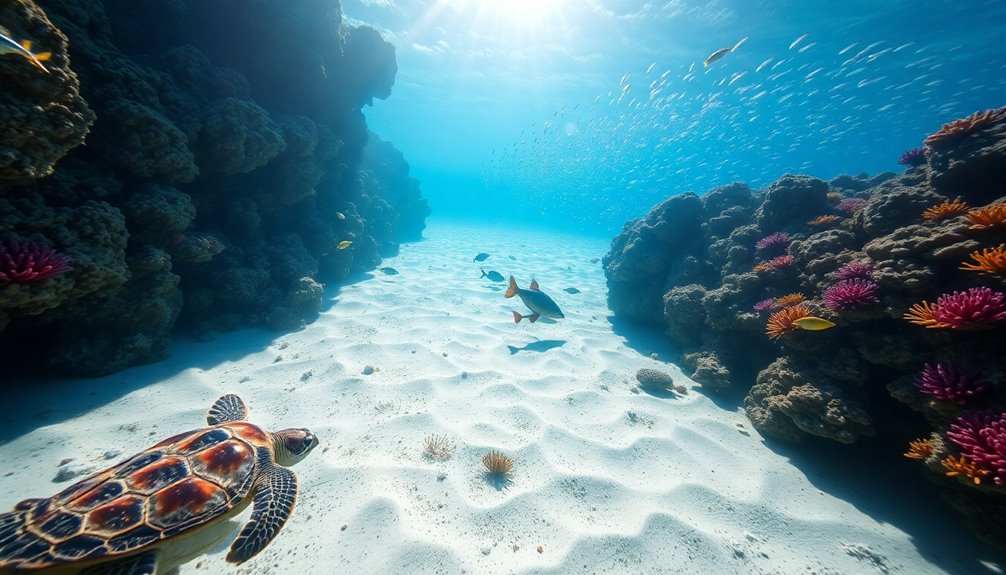
The variety of life on Earth plays a significant role in ensuring the health and stability of our ecosystems. Biodiversity is essential not just for resources like clean air and fresh water but also for food security, impacting over 80% of the global population relying on traditional medicine.
With around 1 million species at risk of extinction due to human activities, strong conservation efforts are necessary to maintain ecosystem resilience. High biodiversity stabilizes climates and limits disease spread, while its decline can lead to severe economic consequences, costing industries up to $338 billion annually.
Protecting biodiversity isn't just about preserving nature; it's about safeguarding our health, livelihoods, and future. Your actions can help support these important efforts.
Ecosystem Services Provided

Ecosystem services are invaluable, contributing approximately $125 trillion annually to human well-being. These services are essential for your survival, providing resources like food, clean water, and air.
Biodiversity enhances the productivity of ecosystems, making them more efficient in supporting critical services, such as pollination for 75% of food crops.
Consider these key benefits of healthy ecosystems rich in biodiversity:
- Regulation of climate by absorbing significant CO2, mitigating climate change impacts.
- Water purification and flood reduction, which protect communities and enhance resilience to natural disasters.
- Support for industries like food, forestry, and ecotourism, preventing potential losses of $338 billion annually due to biodiversity decline.
Understanding ecosystem services helps you appreciate their importance to your life and the planet.
Threats to Biodiversity
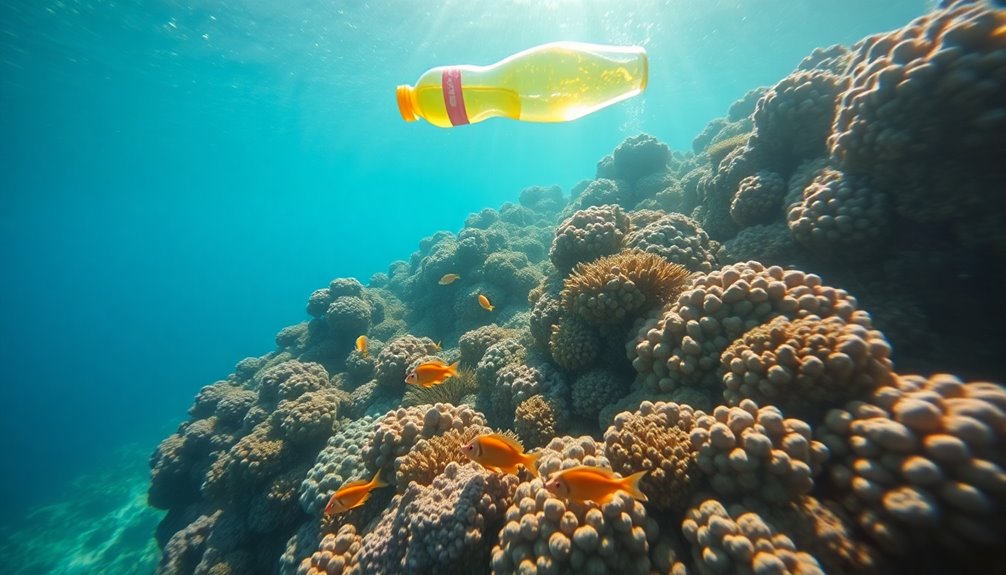
As human activities continue to reshape the planet, biodiversity faces unprecedented threats that jeopardize the delicate balance of ecosystems.
Habitat loss is a major concern, with over 75% of Earth's land altered, leading to declining wildlife populations. You might notice how climate change disrupts habitats, forcing species to adapt quickly or face extinction.
Invasive species further complicate this issue, as they invade and disrupt local ecosystems, often pushing native species toward decline.
Additionally, overexploitation of natural resources, like overfishing and poaching, compounds these threats, resulting in extinction rates drastically higher than natural background rates.
Pollution from plastic waste and chemical runoff also contaminates habitats, threatening the survival of countless species.
It's essential to understand these challenges to protect our planet's biodiversity.
The Current Biodiversity Crisis

While many people mightn't realize it, we're currently facing a biodiversity crisis unlike any before. With extinction rates 1,000 to 10,000 times higher than the natural rate, nearly one-third of all species are threatened.
This crisis is driven by factors like:
- Habitat loss due to urbanization and agriculture
- Pollution and climate change
- Overexploitation of resources
Such biodiversity loss threatens the very ecosystems that provide essential services for human health, including clean air, water, and food sources.
If we don't act soon, we risk not only species survival but also the stability of our ecosystems, which are essential for our well-being.
It's imperative to recognize the urgency of this situation and take steps to protect our planet's biodiversity.
Biodiversity Hotspots

Biodiversity hotspots are critical areas where unique plant species thrive but face significant threats.
You'll find that these regions meet specific criteria, including a high number of endemic species and substantial habitat loss.
Let's explore some global examples and why protecting these hotspots is essential for maintaining our planet's health.
Defining Biodiversity Hotspots
Identifying biodiversity hotspots is essential for understanding global conservation priorities. These regions are critical because they host a remarkable number of endemic species while facing significant threats from habitat loss.
Covering less than 3% of Earth's land, biodiversity hotspots provide crucial ecosystem services that benefit both local and global communities.
Key features of biodiversity hotspots include:
- At least 1,500 endemic vascular plant species.
- A loss of 70% or more of the original habitat.
- Critical regions like Madagascar, the Himalayas, and the Mediterranean Basin.
Criteria for Hotspots
Understanding the criteria that define biodiversity hotspots is essential for effective conservation strategies. To qualify as a hotspot, a region must have at least 1,500 species of vascular plants that are endemic, meaning they're found nowhere else on Earth.
Additionally, it must have lost at least 70% of its original habitat, highlighting significant threats to biodiversity and its ecosystems. Currently, there are 36 recognized biodiversity hotspots, covering less than 3% of the Earth's land surface while hosting over 35% of vertebrate species and 44% of plant species.
Global Hotspot Examples
Around the globe, numerous regions exemplify the rich diversity found within biodiversity hotspots, each hosting unique ecosystems and endemic species.
These hotspots are essential for conservation efforts, as they face significant threats yet hold immense biological wealth.
- The Amazon rainforest, home to about 10% of all known species on Earth, is under siege from deforestation and climate change.
- Madagascar boasts around 90% of its wildlife as endemic, highlighting the urgent need for conservation in its distinct ecosystems.
- The California Floristic Province features approximately 3,500 endemic plant species, all threatened by urban development and invasive species.
Recognizing these hotspots is crucial for preserving biodiversity and ensuring the survival of countless species that contribute to our planet's health.
Conservation Efforts and Strategies
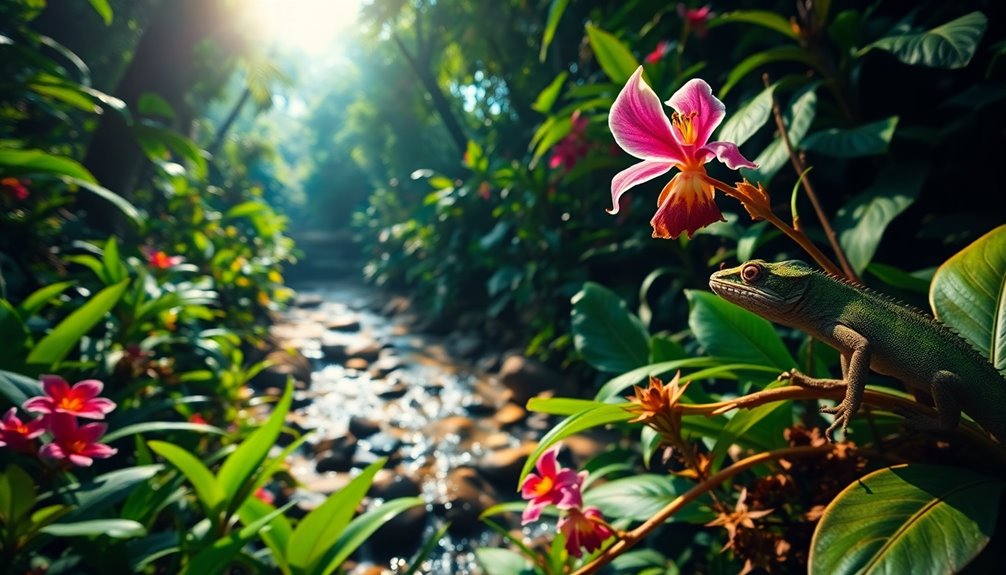
While many recognize the beauty of nature, effective conservation efforts and strategies are fundamental to safeguard our planet's biodiversity. Over 100,000 protected areas around the globe serve as essential refuges for wildlife habitats and endangered species.
You can play a role in these efforts by supporting habitat restoration, species reintroduction, and invasive species control, which are critical for maintaining healthy ecosystems. Legislative measures like the Endangered Species Act create frameworks to protect species that are at risk.
Engaging with your community and valuing local input fosters sustainable resource management and strengthens public support for these initiatives. Together, we can contribute to a healthier planet and guarantee that our diverse species continue to thrive.
Success Stories in Conservation
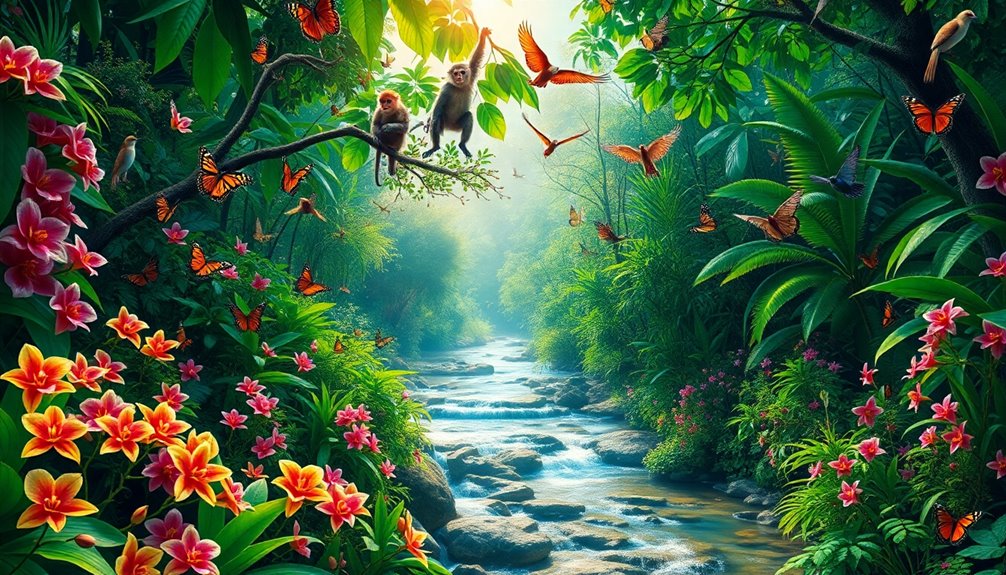
Success in conservation isn't just a dream; it's a reality showcased by numerous inspiring examples worldwide.
These success stories demonstrate how dedicated efforts can revive ecosystems and protect biodiversity.
- The bald eagle population rebounded from 417 nesting pairs in 1963 to over 316,700 by 2009, thanks to the ban on DDT and the Endangered Species Act.
- In Madagascar, community-managed marine areas increased fish catches by 20%, crucial for sustainable livelihoods.
- The reintroduction of gray wolves in Yellowstone restored ecological balance, benefiting various species and enhancing vegetation health.
These cases highlight the effectiveness of conservation strategies in revitalizing endangered species and promoting healthier ecosystems, proving that collective action can lead to meaningful change.
Community Involvement Approaches
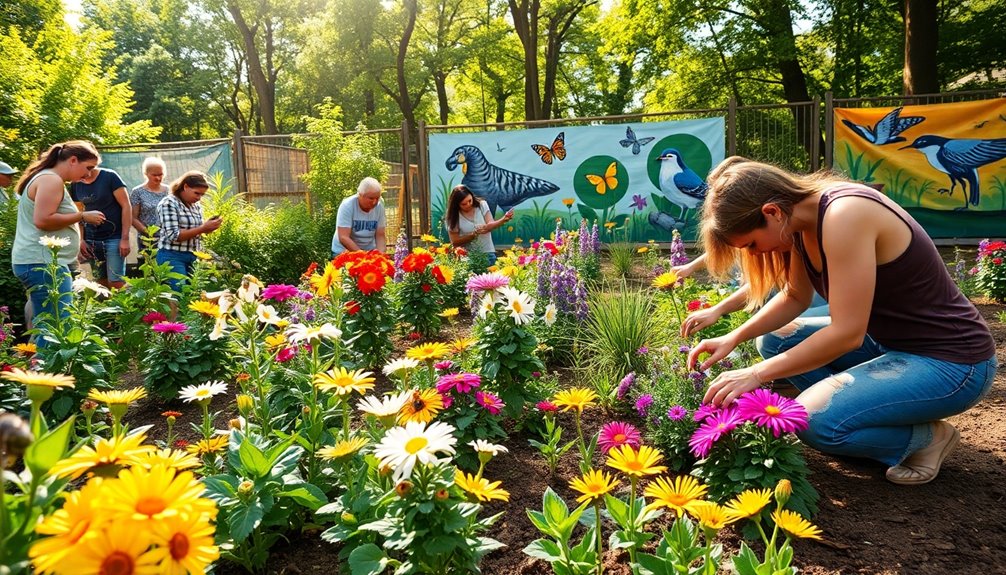
Getting involved in local biodiversity projects can make a big difference in your community.
You can volunteer for local initiatives, participate in citizen science, or advocate for conservation policies that protect wildlife.
Every action counts, and your participation can help foster a healthier environment for everyone.
Volunteer for Local Projects
Have you ever considered how your time and effort can make a real difference in your community's biodiversity?
When you volunteer for local projects, you directly contribute to the conservation of threatened species and ecosystems. Engaging in activities like habitat restoration or wildlife monitoring not only helps the environment but also fosters a sense of community.
- Plant native species to improve local ecosystems.
- Participate in wildlife monitoring to support conservation efforts.
- Connect with others who share your passion for nature.
Participate in Citizen Science
Participating in citizen science projects is a powerful way to contribute to biodiversity research while deepening your connection with nature. By gathering data on local wildlife, you help scientists track species populations and distribution, which is essential for conservation efforts.
Engaging in activities like wildlife surveys or habitat restoration not only enhances your understanding of local ecosystems but also empowers your community to take action. Many initiatives, such as the Audubon Society's Christmas Bird Count, have provided valuable long-term data that informs conservation strategies.
Your involvement can make a difference, as citizen scientists often gather data faster and at a scale that professional scientists can't achieve alone. So, immerse yourself and participate in citizen science to protect our natural resources!
Advocate for Conservation Policies
While advocating for conservation policies might seem intimidating, your voice can drive significant change in protecting biodiversity. By engaging with local and national policymakers, you help guarantee that conservation initiatives reflect the needs of your community and protect the ecosystems that we rely on.
Your involvement can greatly impact biodiversity preservation, especially when addressing habitat destruction and supporting sustainable land-use practices.
- Join or support local conservation organizations to amplify grassroots movements.
- Participate in community discussions to share your insights and concerns.
- Advocate for policies that protect endangered species and their habitats.
Together, these actions can influence the development and enforcement of effective conservation policies, promoting a healthier environment for all.
How to Help Biodiversity

You can make a significant impact on biodiversity by taking direct actions in your community and beyond. Support local partners like conservation organizations through donations or volunteer work; they're essential for protecting biodiversity.
Adopt sustainable living practices—reduce waste, recycle, and conserve energy to lessen your ecological footprint and safeguard habitats.
Get involved in citizen science projects to monitor local wildlife, providing valuable data for conservation efforts.
Advocate for policies that protect natural habitats, as legislative support is critical for effective resource management.
Finally, educate others about the importance of biodiversity and how they can help. By fostering community commitment to conservation, you'll enhance not only biodiversity but also the health and well-being of your environment.
Frequently Asked Questions
What Is Biodiversity and Why Do We Care About It?
Biodiversity's all about the variety of life around you, from the smallest microbes to the largest mammals.
You care about it because it's vital for healthy ecosystems that provide clean air, water, and food.
When you protect biodiversity, you're also safeguarding essential services that support your economy and health.
Plus, a rich variety of species helps prevent the spread of diseases, keeping you and your community healthier.
What Is Biodiversity and Its Importance?
Imagine a world without the vibrant colors of flowers or the songs of birds.
Biodiversity's the lifeblood of our planet, supporting ecosystems and ensuring the balance of nature. It's essential for pollination, water purification, and climate regulation.
Without it, food security and human health are at risk. As you explore this intricate web of life, you'll see how interconnected everything is and why preserving biodiversity is imperative for a thriving future.
What Are 5 Reasons Why Biodiversity Is Important?
You should care about biodiversity because it supports ecosystem services fundamental for life.
First, it provides clean air and water.
Second, it guarantees food security by aiding pollination.
Third, diverse ecosystems are more resilient to climate change and extreme weather.
Fourth, it's essential for economic stability, preventing losses in industries like agriculture and ecotourism.
Finally, biodiversity boosts health through medicinal resources, making it critical for both nature and humanity's future.
What Is a Simple Definition of Biodiversity?
Biodiversity refers to the variety of life forms on Earth, including different species, genetic variations, and ecosystems.
It's not just about the number of species; it's about the interconnectedness of them all. When you think about it, biodiversity supports ecosystem health, which directly affects your environment and well-being.
From the air you breathe to the food you eat, a rich diversity of life is essential for sustaining the planet and your quality of life.
Conclusion
Biodiversity isn't just a buzzword; it's essential for our planet's health and our survival. Did you know that over 1 million species are currently at risk of extinction, many within decades? By valuing and protecting biodiversity, you're not just preserving beautiful landscapes and wildlife—you're ensuring clean air, fresh water, and healthy soils for future generations. Get involved, support conservation efforts, and make choices that foster a vibrant, resilient ecosystem. Every effort counts!
